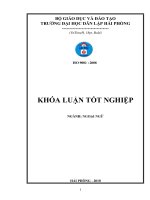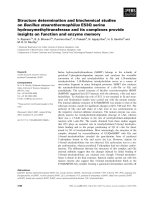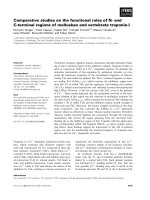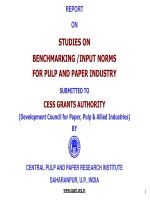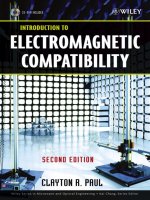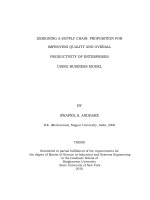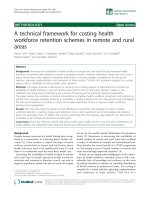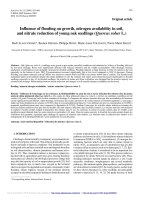Studies on chain sampling schemes in quality and reliability engineering
Bạn đang xem bản rút gọn của tài liệu. Xem và tải ngay bản đầy đủ của tài liệu tại đây (3.47 MB, 210 trang )
STUDIES ON CHAIN SAMPLING SCHEMES
IN QUALITY AND RELIABILITY ENGINEERING
GAO YINFENG
NATIONAL UNIVERSITY OF SINGAPORE
2003
STUDIES ON CHAIN SAMPLING SCHEMES
IN QUALITY AND RELIABILITY ENGINEERING
GAO YINFENG
(B.ENG; M.ENG)
A THESIS SUBMITTED
FOR THE DEGREE OF DOCTOR OF PHILOSOPHY
DEPARTMENT OF INDUSTRIAL AND SYSTEMS ENGINEERING
NATIONAL UNIVERSITY OF SINGAPORE
2003
Acknowledgements
I would like to express my sincere gratitude to my supervisor, Associate Professor
Tang Loon Ching for his kind help, patient guidance and valuable comments. He is a
constant source of encouragement and original ideas not only about research but also
about life. He is both a supervisor and a friend and, in many cases, more like a friend.
It is really lucky for me to have such a supervisor to guide me through the course of
this tough research.
My sincere thanks are conveyed to the National University of Singapore for offering
me a Research Scholarship and to the Department of Industrial and Systems
Engineering for use of its facilities, without which it would not be possible for me to
complete my work in this dissertation. My thanks also send to my colleagues in ISE
department who have provided me their kind help continuously.
Finally, I would take this chance to express my appreciation to my family, my parents,
wife, and the little son for their love, concern, continuous care and moral support,
which are the sources of drives to motivate me to strive for a better and better life.
I
Table of Contents
Acknowledgements I
Table of Contents II
Summary IV
List of Tables VI
List of Figures VII
Nomenclature IX
1. Introduction 1
2. Literature Review 7
2.1 Historical Development of Acceptance Sampling 7
2.2 Chain Sampling Plan 9
2.3 Correlated Production 12
2.4 Effect of Inspection Errors 14
2.5 Reliability Acceptance Test 16
3. Chain Sampling Plan for Correlated Production 17
3.1 Introduction 17
3.2 Chain Sampling Plan for Markov Dependent Process 19
3.3 Results and Discussion 25
3.4 Conclusion 33
4. Chain Sampling Scheme under Inspection Errors (Ι: For Constant Errors) 34
4.1 Introduction 34
4.2 Mathematical Model 36
4.2.1 Single sampling plan with inspection errors 36
4.2.2 Mathematical Model for Chain Sampling Plans, ChSP (c
1
, c
2
) r 39
4.2.3 Average Outgoing Quality 42
4.2.4 Average Total Inspection 44
4.3 Analysis and Discussion 45
4.3.1 Effects of Inspection Errors 45
4.3.2 Effect on OC Curve 49
4.3.3 Effects on AOQ and ATI 54
4.3.4 Effects of other sampling parameters 60
4.4 Conclusion and Remark 66
5. Chain Sampling Scheme under Inspection Errors (ΙI: For Varying Errors) 70
5.1 Introduction 70
5.2 Mathematical Model 71
5.2.1 Chain sampling plan for linearly varying inspection error. 71
5.2.2 AOQ and ATI 73
5.2.3 Parameter Estimation 74
5.3 Analysis and Discussion 75
5.3.1 Effects of Inspection Errors 75
5.3.2 Effect on OC Curve 77
5.3.3 Effects on AOQ and ATI 86
5.4 Conclusion and Remark 94
6. Design of Chain Sampling Plan for Inspection Errors 97
6.1 Introduction 97
6.2 Binomial model and tables 97
6.3 Solution Algorithm 103
II
6.5 Conclusion 108
7. Chain Sampling Plan for Reliability Acceptance Test 110
7.1 Introduction 110
7.2 Chain Sampling Plan for Reliability Acceptance Test 111
7.3 Exponential Examples 113
7.4 Conclusion and Remark 121
8. Conclusions and Remarks 123
Reference 128
Appendix A Tables for Chain Sampling Plan 151
Appendix B The Use of a Ratio Test in Multi-Variate SPC 161
Appendix C SWOT Analysis of Six Sigma Strategy 175
III
Summary
Chain Sampling scheme is the first topic covered in this thesis. The interest in chain
sampling plans is sparked by an industry project, in which a suitable sample scheme is
required to conduct destructive test on fire-retard door and fire-retard cable. Some
features of this testing are: (I) this testing is destructive, so it is favorable to take as
few samples as possible, and (II) testing units are selected from the same continuous
process and it is reasonable to expect a certain kind of relationship between the
ordered samples. For example, units after good units (conformities) are more likely to
be good, and bad units (non-conformities) are more likely to happen after bad units. In
our research, we proposed a chain-sampling plan for Markovian process to address
these problems. The chain sampling has it unique strength in dealing with scarce
information and a two stage Markov chain model is demonstrated to be able to model
such process adequately.
Another important assumption for chain sampling plan is the error-free inspection
assumption, which assumes that inspection procedures are completely flawless. In
reality, however, inspection tasks are seldom error free. While inspection errors
incurred during acceptance sampling for attributes are often unintentional and in most
cases neglected, they nevertheless can severely distort the quality objective of a
sampling system design. This motivated our study of the effect of inspection errors on
chain sampling schemes to be part of our chain sampling studies.
The error study of chain sampling plans is done through three phases: 1. the effect of
constant inspection errors; 2. the effect of variable inspection errors; and 3. the design
of chain sampling plan under inspection error. The first two stages is the basis of the
inspection error study and the final stage, design of chain sampling plan, completes
IV
this study on inspection errors. The ultimate goal of this series of error study is to
devise a procedure to design chain-sampling plan under error inspection. This
includes the binomial model, the proposed design approach and its series of tables etc.
After complete the correlation and error effect of chain sampling, we find that the
chain inspection actually can have a much broader application in such areas as
reliability acceptance test and the high yield process etc. An outline of its application
in reliability test is given and demonstrated.
Some additional work has been done during the course of my research stint in NUS,
which have their unique contributions in terms of researching. However, it is not very
consist with the above-mentioned topics and not easy to be incorporated in a cohesive
structure. Rather than simply drop them off, we decide to document them in the
appendix for future reference. These include the mathematical deviation of ratio of
two normal in the multivariate process control and the SWOT (Strengths, Weaknesses,
Opportunities and Threats) analysis to Six Sigma Strategy.
V
List of Tables
Table 4. 1Types of inspection errors 37
Table 6. 1 Table for chain sampling plans 102
Table 7. 1Test time for chain sampling reliability acceptance test (
0
/
θ
T ) 115
Table 7. 2 Test time for chain sampling reliability acceptance test (
1
/
θ
T
) 116
Table 7. 3 Value of
01
/
θ
θ
for chain sampling reliability acceptance test 117
VI
List of Figures
Figure 2. 1Dodge Chain Sampling Plan 10
Figure 2. 2Chain Sampling Plan (4A) 11
Figure 3. 1OC curve of new model (i=5, n=5) 26
Figure 3. 2AOQ curve of new model (i=5, n=5) 26
Figure 3. 3 OC curve comparison of sample size (i=5, δ =0.4) 27
Figure 3. 4 OC curve comparison of sample size (i=5, δ =1) 28
Figure 3. 5 OC curve comparison of sample size (i=5, δ =1.4) 28
Figure 3. 6 AOQ comparison of sample size (i=5, δ =0.4) 29
Figure 3. 7 AOQ comparison of sample size (i=5, δ =1) 29
Figure 3. 8 AOQ comparison of sample size (i=5, δ =1.4) 29
Figure 3. 9 OC curve comparison of lots no. (n=10, δ=0.4) 30
Figure 3. 10 OC curve comparison of lots no. (n=10, δ=1.0) 30
Figure 3. 11 OC curve comparison of lots no. (n=10, δ=1.4) 31
Figure 3. 12 AOQ curve comparison of lots no. (n=10, δ=0.4) 32
Figure 3. 13 AOQ curve comparison of lots no. (n=10, δ=1.0) 32
Figure 3. 14 AOQ comparison of lots no. (n=10, δ=1.4) 32
Figure 4. 1Probability tree for chain sampling plans 40
Figure 4. 2 3D plot of effects of inspection errors 46
Figure 4. 3 Screen snapshot of the program input interface 48
Figure 4. 4 Screen snapshot of inspection error rang 48
Figure 4. 5 OC curves for ChSP (2, 5)5, n =5, (k-1) =5 with type I inspection errors.49
Figure 4. 6 OC curves for ChSP (2, 5)5, n =5, (k-1) =5 with type II inspection errors 50
Figure 4. 7 OC curve for combined inspection errors (ChSP (2, 5)5, n =5, (k-1) =5) 50
Figure 4. 8 Program input of the OC curve analysis 51
Figure 4. 9 Effect of roundup error 54
Figure 4. 10 Program input interface for AOQ and ATI analysis 55
Figure 4. 11 AOQ curve of type II inspection error (e
1
=0) 56
Figure 4. 12 AOQ curve of type II inspection error (e
1
=0.2) 56
Figure 4. 13 AOQ curve of type I inspection error (e
2
=0) 57
Figure 4. 14 AOQ curve of type II inspection error (e
2
=0.1) 57
Figure 4. 15 AOQ curve of increased type I inspection error (e
2
=0) 58
Figure 4. 16 AOQ curve of increased type I inspection error (e
2
=0.01) 58
Figure 4. 17 ATI curve of increased type II inspection error (e
1
=0) 59
Figure 4. 18 ATI curve of increased type I inspection error (e
2
=0) 60
Figure 4. 19 Effects of lot size (1) 61
Figure 4. 20 Effects of lot size (2) 62
Figure 4. 21 Effects of sample size 63
Figure 4. 22 Effect of c
1
64
Figure 4. 23 Effects of k, number of lots 65
Figure 4. 24 Effects of rejection no. r 66
Figure 4. 25 Effects of c
2
66
VII
Figure 5. 1 3D Plot of effects of varying inspection errors 76
Figure 5. 2 Screen snapshot of the program input interface of Figure 5.1 77
Figure 5. 3 Program input of the OC curve analysis for linear error model 78
Figure 5. 4 OC curves for type I inspection errors (e
2
=0) 79
Figure 5. 5 OC curves for type I inspection errors (e
2
=0.2) 80
Figure 5. 6 Comparison of linear model and constant model (e2=0, e1=0.1) 80
Figure 5. 7 Comparison of linear model and constant model (e2=0, e1=0.2) 81
Figure 5. 8 Comparison of linear model and constant model (e2=0.2, e1=0.1) 81
Figure 5. 9 Comparison of linear model and constant model (e
1
=0, e
2
=0.1) 83
Figure 5. 10 Comparison of linear model and constant model (e
1
=0, e
2
=0.1) 83
Figure 5. 11 Comparison of linear model and constant model (e
1
=0.1, e
2
=0.1) 84
Figure 5. 12 Comparison of linear model and constant model (e
1
=0.01, e
2
=0.01) 85
Figure 5. 13 Program input interface for AOQ and ATI analysis (LM) 87
Figure 5. 14 AOQ curve of different type II inspection error (e
1
=0) 88
Figure 5. 15 AOQ curve of different type II inspection error (e
1
=0.2) 88
Figure 5. 16 AOQ curve for LM and CM (e
1
=0, e
2
=0.01) 89
Figure 5. 17 AOQ curve for LM and CM (e
1
=0, e
2
=0.02) 89
Figure 5. 18 AOQ curve for LM and CM (e
1
=0.02, e
2
=0.02) 90
Figure 5. 19 AOQ curve of increased type I inspection error (e
2
=0) 91
Figure 5. 20 AOQ curve of different type I inspection error (e
2
=0.01) 91
Figure 5. 21 AOQ curve for LM and CM (e
2
=0, e
1
=0.01) 92
Figure 5. 22 AOQ curve for LM and CM (e
2
=0, e
1
=0.02) 92
Figure 5. 23 AOQ curve for LM and CM (e
2
=0.02, e
1
=0.01) 93
Figure 5. 24 ATI for LM model (e
1
=0) 93
Figure 5. 25 ATI for LM model (e
2
=0) 94
Figure 6. 1 Solution algorithm to design chain sampling plans 106
Figure 6. 2 OC curves for both sampling schemes 108
Figure 7. 1Excel template for example 7.1 119
Figure 7. 2 Excel template for example 7.2 120
Figure 7. 3 Excel template for example 7.3 121
VIII
Nomenclature
N
Lot size
D Number of nonconforming items in a lot
n
Sample size
y
Number of nonconforming items in a sample
z Number of observed nonconforming items in a sample
m
z Number of items in a sample classified as nonconforming in the mth
preceding lot,
ranging from 0 to
m 1
−
k
with 0 denoting the current lot
total
z Total number of items classified as nonconforming from the current as
well as the previous
1
−
k
lots
pre
z
0
zz
total
−
c
Acceptance number of a sampling plan
1
c
Acceptance number for the first stage
2
c
Acceptance number for the cumulative stage
r
Rejection number
k
Total number of lots (inclusive of the current lot) used in ChSP
1
e
Probability that a conforming item is observed as nonconforming
2
e
Probability that a nonconforming item is observed as conforming
w
Number of nonconforming items classified as nonconforming
w
′
Number of conforming items classified as nonconforming
p
True fraction of nonconforming items in a lot
q
pq −= 1
π
Apparent (observed) fraction of nonconforming items in a lot
a
P Probability of acceptance
IX
s
P Probability of acceptance for a single sampling plan
ch
P Probability of acceptance for a chain-sampling plan
AOQ
Average Outgoing Quality
A
TI Average Total Inspection
X
Chapter 1 Introduction
1. Introduction
Quality and reliability engineering has gained its overwhelming application in
industries as people become aware of its critical role in producing quality product
and/or service for quite a long time, especially since the beginning of last century. It
has been developed into a variety of areas of research and application and is
continuously growing due to the steadily increasing demand.
Acceptance sampling is one field of Statistical Quality Control (
) with longest
history. Dodge and Romig popularized it when U.S. military had strong need to test its
bullets during World War Two. If 100 percent inspection were executed in advance, no
bullets would be left to ship. If, on the other hand, none were tested, malfunctions
might occur in the field of battle, which may result in potential disastrous
result. Dodge proposed a “middle way” reasoning that a sample should be selected
randomly from a lot, and on the basis of sampling information, a decision should be
made regarding the disposition of the lot. In general, the decision is either to accept or
reject this lot. This process is called Lot Acceptance Sampling or just Acceptance
Sampling.
SQC
Single sampling plans and double sampling plans are the most basic and widely
applied testing plans when simple testing is needed. Multiple sampling plans and
sequential sampling plans provide marginally better disposition decision at the expense
of more complicated operating procedures. Other plans such as the continuous
sampling plan, bulk-sampling plan, and Tighten-normal-tighten plan etc., are well
developed and frequently used in their respective working condition.
Among these, chain-sampling plans have received great attention because of their
unique strength in dealing with destructive or costly inspection, which the sample size
1
Chapter 1 Introduction
is kept as low as possible to minimize the total inspection cost without compromising
the protection to suppliers and consumers. Some characteristics of these situations are
(I) the testing is destructive, so it is favorable to take as few samples as possible,
and/or (II) physical or resource constraint makes mass inspection an insurmountable
task.
The original chain sampling plan-1 (ChSP-1) was devised by Dodge (1977) to
overcome the inefficiency and less discriminatory power of the single sampling plan
when the acceptance number is equal to zero. Two basic assumptions embedded with
the design of chain sampling plans are independent process and perfect inspection,
which means all the product inspected are not correlated and the inspection activity
itself is error free. These assumptions make the model easy to manage and apply,
though they are challenged as manufacturing technology advances.
The interest of studying chain-sampling plans was driven by a real industrial project,
where appropriate sampling plans were required to test fire-retard door and fire-retard
cable.
Some features of this testing are: (I) this testing is destructive, so it is favorable to take
as few samples as possible, and (II) testing units are selected from the same continuous
process and it is reasonable to expect a certain kind of relationship between the ordered
samples. For example, units after good units (conformities) are more likely to be good,
and bad units (non-conformities) are more likely to happen after bad units.
For the first problem, suitable sampling schemes are needed and chain-sampling plan
stands up to be a perfect candidate because of its power in making use of the limited
information. As for the second question, a suitable way needs to be found to capture
the dependency between testing units. This becomes the starting point of our research
on the chain sampling schemes. The problem actually addresses one of the underlying
2
Chapter 1 Introduction
assumptions for the chain sampling plan uncorrelated process. In the original ChSP-1,
all products inspected are assumed to come from the same process and follow an
identical independent distribution (i.i.d.). This strict assumption has to be relaxed in
our project and a Markovian model is proposed later on to model this kind of
correlation.
Another important assumption for chain sampling plan is the error-free inspection
assumption, which assumes that inspection procedures are completely flawless. In
reality, however, inspection tasks are seldom error free. On the contrary, they may
even be error prone. A variety of causes may contribute to these error commitments.
In manual inspection, errors may result from factors such as the complexity and
difficulty of the inspection task, inherent variation in the inspection procedure,
subjective judgment required by human inspectors, mental fatigue and inaccuracy or
problem of gages or measurement instruments used in the inspection procedures.
Automated inspection system has been introduced to reduce the inspection time as well
as to eliminate errors incurred as a result of human fatigue. However, inspection errors
may still be present due to factors such as complexity and difficulty of the inspection
task, resolution of the inspection sensor, equipment malfunctions and “bugs” in the
computer program controlling the inspection procedure etc. In short, any activities
related to human being are subject to mistake as “To err is human”.
There are two types of errors present in inspection schemes, namely, Type I and Type
II inspection errors, where Type I inspection error refers to the situation in which a
conforming item is incorrectly classified as nonconforming and Type II error occurs
when a nonconforming unit is erroneously classified as conforming.
While inspection errors incurred during acceptance sampling for attributes are often
unintentional and in most cases neglected, they nevertheless can severely distort the
3
Chapter 1 Introduction
quality objective of a sampling system design. This motivated our study of the effect
of inspection errors on chain sampling schemes to be part of our chain sampling
studies. This research has been completed phase by phase in three stages, the effect of
constant inspection errors, the effect of variable inspection errors and the design of
chain sampling plan under inspection errors.
The final part of this thesis goes to the reliability engineering, while the previous two
topics fall in the category of quality engineering. In this part, the chain sampling is
extended to reliability acceptance test and (a new approach to design chain sampling
plans for reliability acceptance test is proposed) proposes our approaches to design
chain-sampling plans for reliability acceptance test. Its mathematical models are
relatively straightforward, but results are useful in application.
Some additional work has been done during the course of my research stint in NUS,
which have their unique contributions in terms of researching. However, it is not very
consist with the above-mentioned topics and not easy to be incorporated in a cohesive
structure. Rather than simply drop them off, we decide to document them in the
appendix for future reference. These include the mathematical deviation of ratio of two
normal in the multivariate process control and the SWOT (Strengths, Weaknesses,
Opportunities and Threats) analysis to Six Sigma Strategy.
A detail review of related topics will be presented in the next chapter, which includes
the historical development of acceptance sampling, the review of chain sampling plan
and the study of correlated production, the effect of inspection errors on the acceptance
sampling, specifically, the error effect on chain sampling plan, and the chain sampling
plan for production reliability acceptance test.
In chapter three, the effect of correlation on chain sampling plan will be studied. This
study can be served as an abstract and extension of an industrial project. A new model
4
Chapter 1 Introduction
named as Chain Sampling Plan with Markov Property is developed, and the numerical
analysis is conducted. Some parameter study is also included.
Chapter four starts the study of the effect of inspection errors on chain sampling plan,
in which inspection errors are assumed constant throughout inspection, i.e. the constant
error model. In this chapter, the inspection error is considered in chain sampling
schemes and a mathematical model is constructed to investigate the performance of
chain sampling schemes when inspection errors are taken into consideration.
Expressions of performance measures are derived, such as the operating characteristic
function, average total inspection and average outgoing quality to aid the analysis of a
general chain sampling scheme, ChSP-4A (c1, c2) r, developed by Frishman (1960).
Chapter five is a counterpart of chapter four with the underlying assumption changed
from constant inspection error to variable inspection error The variable error is in fact
very complicated, so Biegel (1974) linear model is adopted to simplify the problem.
The similar study is conducted in chapter four and five so as to highlight the difference
between two models.
Chapter six is the most important part of the inspection error effect study. Procedures
of designing chain-sampling plans are proposed when constant inspection errors are
taken into consideration. Two approaches to design chain-sampling plans for imperfect
inspection are proposed with the comparison and examples included for reference.
Chapter seven focuses on the application of chain sampling plan in Reliability
Acceptance Testing (RAT) or Product Reliability Acceptance Testing (PRAT), in
which this chain sampling scheme for reliability acceptance test is proposed to
complement the existing commonly used two schemes: single sampling plan and
sequential sampling plan. In addition to the mathematical description, tables for the
selection of sampling parameter, and Excel templates are also provided to facilitate
5
Chapter 1 Introduction
designing and flexible usage. Examples are included to illustrate the application of
proposed methods.
A summarization of results and conclusions is presented in chapter eight, from which a
quick understanding of this study on chain sampling schemes can be found. Reference
is listed after chapter eight and the appendix part can be found after reference.
6
Chapter 2 Literature Review
2. Literature Review
2.1 Historical Development of Acceptance Sampling
The development of the statistical science of acceptance sampling has a long history
that can be traced back to the formation of the Inspection Engineering Department of
Western Electric’s Bell Telephone Laboratories in 1924. The department made lots of
contributions in this area and some members of the department became gurus in this
area later such as H.F. Dodge, who is considered by some to be the father of
acceptance sampling. Other pioneers were W.A. Shewhart, Juran and H.G. Romig.
In 1924, Shewhart from this department presented the first control chart, the symbolic
start of the era of statistical quality control (SQC). Meanwhile, many, if not most, of
the acceptance sampling terminologies was coined by this department between 1925 to
1926 such as single sampling plan, double sampling plan, consumer’s risk, producer’s
risk, probability of acceptance, OC curves, ATI etc. In 1941, H.F. Dodge and H.G.
Romig published the famous Dodge-Romig table “Single Sampling and Double
Sampling Inspection Tables”, which provided plans based on fixed consumer risk
(LTPD protection) and also plans for rectification (AOQL protection), which
guaranteed stated protection after 100 percent inspection of the rejected lots.
The Second World War witnessed a great development of quality control and
particularly acceptance sampling. This included the development, by the Army’s
Office of the Chief of Ordnance (1942), of “Standard Inspection Procedures” of which
the Ordnance sampling tables, using a sampling system based on a designated
acceptable quality level, were a part. Also in this period, H.F. Dodge (1943) developed
a sampling plan for continuous production indexed by AOQL and A. Wald (1943), a
member of the Statistical Research Group in Columbia University, put forward his
7
Chapter 2 Literature Review
new theory of sequential sampling which was the ultimate extension of multiple
sampling plans, where items were selected from a lot one at a time and after inspection
of each item a decision was made to accept or reject the lot or select another unit.
The Statistical Research Group of Columbia University (1945) made outstanding
contributions during the Second World War. Their output consisted of advancements
in variables and attributes sampling in addition to sequential analysis. Some of these
were documented in the Statistical Research Group (1947) “Techniques of Statistical
Analysis.” They were active in theoretical developments in process quality control,
design of experiments, and other areas of industrial and applied statistics as well. Out
of the work of the Statistical Research Group came a manual on sampling inspection
prepared for the U.S navy, office of Procurement and Material. Like the Army
Ordnance Tables, it was a sampling system based on specification of an acceptable
quality level (AQL) and was later published by the Statistical Research Group (1948)
under the title “Sampling Inspection”. In 1949 the manual became the basis for the
Defense Department’s non-mandatory Joint Army-Navy Standard JAN-105. And later,
a committee of military quality control specialists was formed to reach a compromise
between JAN-105 and the ASF tables, which resulted in MIL-STD-105A issued in
1950 and subsequently revised as 105B, 105C and 105D, which was still a handbook
for current inspection practitioners in industries.
The research of acceptance sampling became less active after 1970s and 1980s as more
and more research were streamed into statistical process control and design for quality.
There is clear indication that acceptance sampling is playing a lesser role in research,
which can be easily identified by its decreasing proportion in the Statistical Quality
Control textbooks. However, research paper and works still appear sometime focusing
on the development or improvement of specified acceptance techniques.
8
Chapter 2 Literature Review
2.2 Chain Sampling Plan
The principle of a continuous sampling plan (CSP-1), which was originally applied to
a steady stream of individual items from the process and required sampling of a
specified fraction, f, of the items in order of production, with 100 percent inspection of
the flow at specified times, could be extended to apply to a continuing series of lots or
batches of material rather than to individual product units. This led Dodge (1955) to
propose the skip-lot sampling plan (SkSP). Its underlying principle was almost the
same as that of the CSP and the only difference lied in that the SkSP plans dealt with
series of lots or batches while the CSP plans handled with series of units. The
application of these plans and ideas was formulized by Dodge and Perry (1971), Perry
(1970, 1973a, 1973b) and later documented by ANSI/ASQC Standard S1-1987 (1987).
Both the continuous sampling plan and skip-lot sampling plan were members of, so-
called, cumulative results plans, which made decision not only based on the current lot,
but also made use of the cumulative lots information. Another member of this
cumulative results plans is the chain sampling plan (ChSP) introduced by Dodge
(1955), which made use of previous lots results, combining with the current lot
information, to achieve a reduction of sample size while maintaining or even extending
protection. The ChSP plans were first conceived to overcome the problem of lack of
discrimination of the single sampling plan when acceptance number c=0, and had been
received wide application in industries where the test is either costly or destructive. Its
operating procedure is illustrated in Figure2.1.
9
Chapter 2 Literature Review
Figure 2. 1Dodge Chain Sampling Plan
Zwickl (1963) and Soundarajan (1978a and 1978b) had carried out further evaluations
of ChSP-1 type sampling plans. Since the invention of ChSP-1, numerous works had
been done on the extensions to chain sampling plans. These included plans designated
ChSP-2 and ChSP-3, which was done by Dodge (1958) but kept unpublished, partly
due to the complexities of its operating procedures. Frishman (1960) presented
extended chain sampling plans designated ChsSP-4 and ChSP-4A (perhaps
contemplating publication of designations 2 and 3 by Dodge). His plans were
developed from an application in the sampling inspection of torpedoes for Naval
Ordnance as a check on the control of the production process and test equipment
(including 100% inspection). Features of these plans included a basic acceptance
number greater than zero, an option for forward or backward accumulation of results
for an acceptance-rejection decision on the current lot, and provision for rejecting a lot
on the basis of the results of a single sample (ChSP-4A). Its operating procedure is
illustrated in Figure 2.2.
10
Chapter 2 Literature Review
Second Stage First Stage
For each lot select a sample of n units and test each for the conformance
to the specified requirement(s)
A
ccept the lot if the observed number of defectives, Z
0
is less than or equal
to c
1
.
Reject the lot if Z
0
≥ r
.
Under Backward Cumulation
Under Forward Cumulation
If r > Z
0
> c
1
, accept the lot i
f
the total number of defectives
from the current lot plus the
previous ( k-1) lots, Z
total
, is less
than or equal to c
2
.
Reject the lot if Z
total
> C
2
If r > Z
0
> c
1
, defer action until
an additional (k-1) lots have
been tested. Accept the lo
t
under consideration if the total
number of defectives for the
k
lots, Z
total
is less than or equal to
c
2
.
Reject the lot if Z
total
> c
2
Figure 2. 2Chain Sampling Plan (4A)
Some variations of chain sampling for which cumulative results were used in the
sentencing of lots had also been developed by Anscomber, Godwin, and Plackett
(1947); Page (1955); Hill, Horsnell, and Warner (1959); Ewan and Kemp (1960);
Kemp (1962); Beattle (1962); Cone and Dodge (1964); Wortham and Moog (1970),
and Soundarajan (1978a and 1978b). Further extensions to a general family of chain
sampling inspection plans had been developed by Dodge and Stephens and published
in numerous technical reports, conference papers, and journal articles.
Raju (1996a, 1996b, 1991,1995, 1997) did extensive research work on chain sampling
plan both cooperatively and independently. His contribution included extending idea
of ChSP-1 and devising tables based on the Poisson model for the construction of two-
11
Chapter 2 Literature Review
stage chain sampling plans ChSP (0,2) and ChSP (1,2) under difference sets of criteria,
outlining the structure of a generalized family of three- stage chain sampling plans,
which extended the concept of two-stage chain sampling plans of Dodge and Stephens
(1966). He also authored a series of 5 papers, which presented procedures and tables
for the construction, and selection of chain sampling plans ChSP-4A (c1, c2).
Govindaraju (1998) extended the idea of chain sampling plans to variable inspection
and examined the related properties and listed the desired table.
2.3 Correlated Production
All the abovementioned research works were done based on the assumption of
independent life distributions and perfect inspection. In the other direction of research,
some researchers had questioned the unrealistic assumption of i.i.d. (identical
independent distribution).
Lieberman (1953) presented an analysis of CSP-1 under the assumption that the
probability of a defective unit was not constant for each unit. He found that the worst
situation would be the one where only defective units were produced under fractional
sampling and non-defective unites were produced under 100 percent inspection. In
practice, it was unlikely that automated mass production would follow such a case.
Sackrowitz (1975) studied the unrestricted AOQL and remarked: “What happened
apparently is that, the assumption of statistical control was recognized as being too
restrictive and unrealistic and so was relaxed completely. However, assuming that the
production process could always do anything may be too unrealistic.”
Broadbent (1958) described a production process where a mold continuously produced
glass bottles in an automatic manufacturing process. He reported that non-defective
and defective bottles occurred in runs and suggested, therefore, a Markov model with
12
Chapter 2 Literature Review
non-defective (0) and defective (1) as two states. He introduced a Markovian character
because of the fact that a defect was likely to occur in a succession of bottles from a
single mold until the cause of the defect was corrected.
Preston (1971), while discussing a two-state Markov chain model of a production
process, pointed out that if the serial correlation coefficient of the Markov chain was
positive, long strings of non-defectives and defective were more likely; whereas if the
serial correlation coefficient was negative, alternating sequences of non-defectives and
defectives were more likely.
Rajarshi and Kumar (1983), Kumar, and Rajarshi (1987), studied the behavior of three
continuous sampling CSP-1, CSP-2 and MLP2 under the assumption of a continuous
production process follows a two-state time-homogeneous Markov chain. The AOQL
formula of these plans were also derived and presented. The study shows that if the
serial correlation coefficient of the Markov chain was positive (negative), the AOQL in
increase (decreased) as compared to the case when the successive units in the
production process followed a Bernoulli pattern.
McShane and Turnbull (1991) investigated the performance of CSP-1 when the
production run lengths were short or moderate or when the input process was not i.i.d.
Bernoulli. They considered both rectifying and non-rectifying inspections and
compared the AOQL for the i.i.d. case and the Markov case and the unrestricted
AOQL values. They concluded that great care should be taken in interpreting the AOQ
and AOQL, which were the usual measures of the effectiveness of CSP-1 plans. Even
if the input process was in statistical control, these long-run average measures could be
very deceiving for finite production runs because the AOQ and AOQL may differ from
their finite run counterparts and they didn’t take any measure of variability into
account.
13
